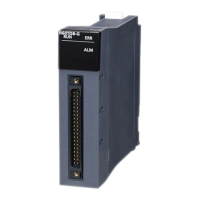25
TERMS
Unless otherwise specified, this manual uses the following terms.
Term Description
Backup mode A mode to continue operation in a redundant system by switching the standby system to the control system when
an error occurs in the control system.
Buffer memory Memory in an intelligent function module for storing data such as setting values and monitored values. When
integrated into the CPU module, this memory refers to a memory for storing data such as setting values and
monitored values of the Ethernet function, and data used for data communication of the multiple CPU system
function.
Control CPU A CPU module that controls connected I/O modules and intelligent function modules. The multiple CPU system
allows the user to assign this control to any CPU module on a module-by-module basis.
Control system A system that controls a redundant system and performs network communications in a redundant system
Control system execution program A program that is executed only in the CPU module of the control system.
CPU Module Logging Configuration Tool Software to configure data logging settings and to manage collected data
Dedicated instruction An instruction that simplifies programming for using functions of intelligent function modules
Device A memory of a CPU module to store data. Devices such as X, Y, M, D, and others are provided depending on the
intended use.
Engineering tool A tool used for setting up programmable controllers, programming, debugging, and maintenance.
FB instance A function block that is inserted to a sequence program
Global label A label that is valid for all the program data when multiple program data are created in the project.
There are two types of global label: a module specific label (module label), which is generated automatically by
GX Works3, and an optional label, which can be created for any specified device.
GX LogViewer Software to display data collected by data logging
Intelligent function module A module that has functions other than input and output, such as an A/D converter module and D/A converter
module
Label A variable consisting of a specified string used in I/O data or internal processing
Module label A label where the I/O signals and buffer memory areas of a module have already been defined.
For the module used, GX Works3 automatically generates this label, which can be used as a global label.
The module labels allow the user to create programs in a simple way, without considering module internal
addresses.
New control system A system that has switched to control system from standby system after system switching
New standby system A system that has switched to standby system from control system after system switching
Own system The system that contains the CPU module that is used for descriptions.
POU A unit that configures a program. Units are categorized and provided in accordance with functions. A program
that is composed of POUs (program organization units) allows the lower-layer processing, when the program is
multi-layered, to be divided into several units by processing and function, enabling the creation of programs
based on each unit.
Process CPU (process mode) A Process CPU operating in process mode.
Process control function blocks and the online module change function can be executed.
Process CPU (redundant mode) A Process CPU operating in redundant mode.
A redundant system is configured with this CPU module. Process control function blocks and the online module
change function can be used even in this mode.
Program block A group of POUs that configure a program
Program executed in both systems A program that is executed in both CPU modules of the control system and the standby system
Redundant function module A module that configures a redundant system and is used with a Process CPU (redundant mode) or a SIL2
Process CPU. The redundant function module model name is R6RFM.
Redundant system A system consisting of two systems that have the same configuration (CPU module, power supply module,
network module, and other modules). Even after an error occurs in one of the two systems, the other system
takes over the control of the entire system. For details, refer to the descriptions of the redundant system in the
following manual.
MELSEC iQ-R Module Configuration Manual
Redundant system with redundant
extension base unit
A redundant system that is configured using extension base unit(s)
Redundant system with redundant
extension base unit
A redundant system that is configured using extension base unit(s)
Separate mode A mode for system maintenance in a redundant system. This mode can maintain a redundant system without
stopping control while the system is running.
Signal flow The execution status that the last time an operation of a program or an FB is executed in each step.
Standby system A backup system in a redundant system

